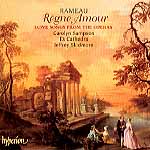This is an amazing recording, and anyone who loves great singing and exciting, exceptionally well-played baroque theatre music will be sorry if they miss what certainly is one of this year’s top vocal releases. It’s also one of those rare performances where everything seems to go right, the repertoire perfectly fits the singer, and the programming ideally showcases composer and musicians while keeping listeners riveted and happy–and I do mean riveted and happy. And who can but marvel at a disc of French baroque opera arias that brings such scintillating life and passion to a genre so often ill-served or simply misunderstood, performances that bash into oblivion any listeners’ previously held notions that such music might be, shall I say it–boring? No, you will not be bored. A few of the stodgiest purists may think some of the dramatic moments over-the-top–but even they won’t be bored.
Soprano Carolyn Sampson certainly is the star here, her vocal virtuosity and vivid characterizations a thing of beauty and a constant source of amazement, but she’s accompanied by one of the best period-instrument bands I’ve ever heard, led by one of today’s more imaginative and exciting conductors, Jeffrey Skidmore. Sampson’s performances owe much to Ex Cathedra’s vibrant, crisply articulated, and rhythmically assured support.
Highlights include the orchestra’s rousing Tambourin I and II from Dardanus, the superbly executed “dialog” between Sampson and orchestra in “Du pouvoir de l’Amour” from Pygmalion (with some impressive trills and other ornamental flourishes by Sampson!) and their even more spectacular collaboration in “Rossignols amoureux” from Hippolyte et Aricie. In this latter song, Sampson shows supreme control and remarkable agility, subtly and instantly varying tone and dynamics, tossing off ornaments with incredible ease and utmost delicacy–and spot-on intonation. Also noteworthy is the chorus, whose several contributions invariably infuse the performance with bursts of brilliant vocal color and physical energy. And speaking of color, the orchestra offers its own surprises, as in the Musettes, résonnez–Menuet en rondeau from Les Indes galantes, where the bagpipe-like musettes, joined by other winds and strings, make their delightful timbres felt against Sampson’s florid solo lines. And when the full-bodied choral voices join in, the effect is absolutely electrifying.
Perhaps Sampson’s–and the orchestra’s–greatest effort is found in one of the final arias, “Aux langueurs d’Apollon” from Platée. There are so many outstanding moments here, packed into four minutes, that it’s hard to mention one without mentioning them all, the interpretive manner and interaction between orchestra and soloist are so perfectly integrated. Nevertheless, it must be said that Sampson’s vocal pyrotechnics alone will have you reaching for the repeat button. Hyperion’s sound is exemplary, bringing the performances clearly and powerfully forward with bracing realism in a brightly lit (some may think too bright) acoustic. We’ve heard Sampson many times before, but this has to be her finest (discographical) hour–and she and her partners leave us with unavoidable imaginings of hearing them together again–and soon! [8/13/2004]
































